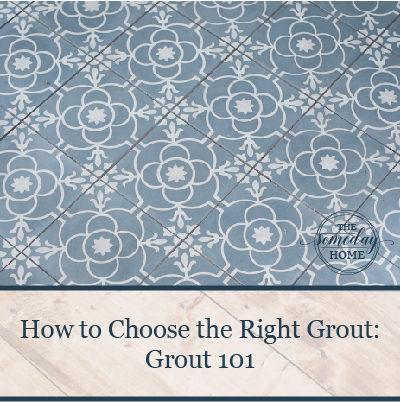When we decided to tackle our basement bathroom, grout was truly an afterthought. We’re tile newbies. We didn’t know what to expect- this bathroom was our very first tiling project. I mean, how many different considerations does a person need to make about tile grout? Much to my surprise, we had a lot to learn, and in true Someday Home fashion, we put ourselves on a stressful timeline to learn it. I’m talking “2-year-old without a nap staring at tile and grout samples in the late afternoon” stressful.
Don’t make the same mistake we made. If you’re getting ready for your first tile project, take a minute to give grout the respect it deserves. I realize that sounds dramatic, but the decisions you make regarding your grout can impact everything from the maintenance and longevity of your tiling job to the overall look and feel of the room in which it resides. There’s too much riding on that decision to merely toss any random bag of dry mix into your cart without doing your homework (which is basically what we did). Convinced? Great. Let’s get started.
Grout 101
Types of Grout
Did you know there are different types of grout? Maybe you did… I’m not sure I ever gave it much thought. Much like anything else in the construction and renovation world, there are a few different options for grouting your tile, and each type is best suited for different applications.
Sanded Grout
Sanded grout is a cement-like mixture with sand added to it to make it resistant to shrinking and cracking. This type of grout is recommended when your grout lines will be larger than 1/8” wide. This is the type of grout we used.

Unsanded Grout
Unsanded grout is a smoother grout, and you guessed it, does not have sand added to it. It’s stickier, making it a good option for tiling walls. Because it doesn’t have the sand in it to prevent shrinkage, it’s not suitable for wider grout lines. Unsanded grout is recommended for grout lines 1/8″ or less.
Epoxy
Epoxy grout is made from epoxy resins and is waterproof, and often used in areas susceptible to staining, such as kitchen backsplashes, tiled countertops, and bathrooms. Although it is durable, some homeowners opt against it because it doesn’t have the same character as sanded and unsanded grout. It can look sort of plastic-y. Also, it does come with a higher price tag, and is more difficult to install. If you’re new to the tiling game and your heart is set on epoxy, it’s probably worth the price tag to hire a professional to do the install here.
Sealing vs Self-sealing
I’ll probably have the tiling and grout community up in arms over this one because to be honest, I’m on the fence about it too. Some grouts require sealing after they’ve fully cured, and others do not. From what I can understand, porous grouts require sealing to avoid staining and ease the cleaning process. Imagine spilling red wine on unsealed concrete- if you allow it to dry, it’ll leave a stain (not speaking from experience or anything…). It makes sense that your porous grout would be the same way, right? Because epoxy grout is nonporous, it does not require sealing.
Now apparently, not everyone is on the same side of this argument… for example, Mike Holmes from Holmes on Homes recommends that you don’t seal your grout (he does mention that it is important to seal your tiles, though, if you’re using a natural stone). According to Holmes, leaving your grout unsealed is important for proper ventilation of your tile. If moisture gets behind your tile (and if it’s in the bathroom or kitchen, it likely will), it needs to be able to evaporate. If you seal your grout, the moisture won’t be able to escape… and as everyone whose ever watched one of those DIY renovation shows on HGTV knows, trapped moisture is always a precursor to disaster.
Grout colors
As a self-proclaimed design junkie, I’m embarrassed to admit that I had no idea just how many grout colors were available! If you’re staring down the planning stages of a tiling project, make sure to get really clear on the overall look you want for your completed project. Although your grout lines account for a small overall area of your project, the right color can make or break your final look.
Contrasting
Are you a puzzle master who has laid out an intricate pattern with your tile? Highlight those Tetris-skills with a grout color that contrasts your tile color! If you want your tile pattern to really stand out, or you want to bring more texture to your room, contrasting grout is the way to go. The dark charcoal-colored grout brings a striking contrast to the white tiles. Paired with the high-texture of the brick wall above it, this wall is full of character.

Complementing
Choosing a complementing grout color can unify the overall look of your design and make your space appear bigger. If you’re using a multi-colored tile like a marble-look or something with a pattern, I would suggest pulling the main color from the tile to match your grout. If your tiles have a busy pattern, matching your grout can be a good way to add an element of calm to help ground what could otherwise be a chaotic look. This is a good option if you want your tile to be the star of the show, as the grout lines won’t pull too much attention away from your tile.



When in doubt, hop on Pinterest and start making note of which overall tile looks you’re most drawn to.


